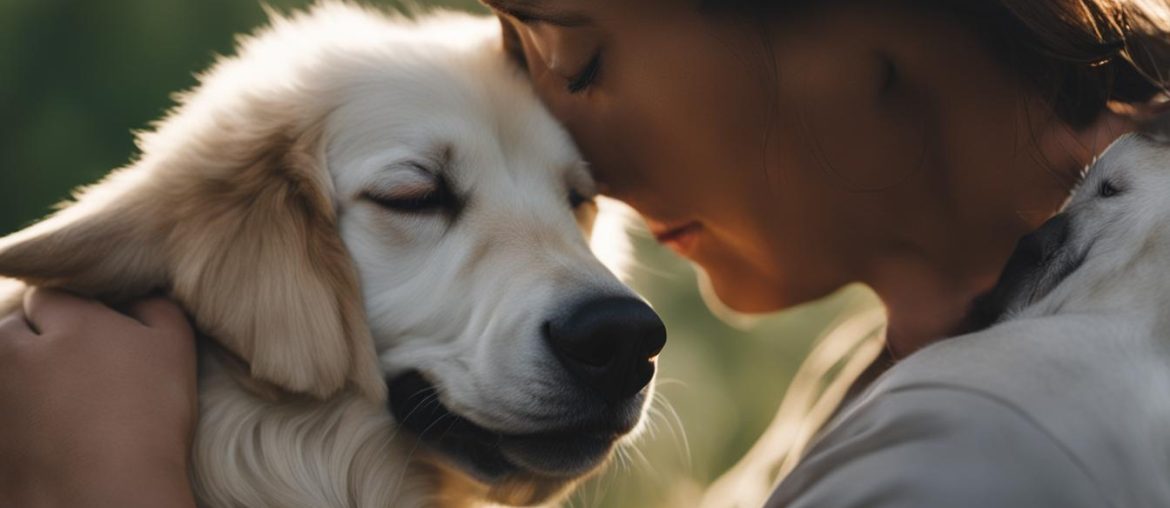As a dog owner, you may have experienced the adorable and sometimes puzzling behavior of your furry friend burying their head into you. This head burying behavior is intriguing, and understanding its reasons can help strengthen the bond between you and your beloved canine companion.
Dogs are known for their complex behaviors, driven by their innate canine instincts and unique ways of communication. Head burying behavior can serve various purposes, such as seeking comfort and security, expressing love and affection, or even conveying specific messages.
By delving deeper into the fascinating world of dog behavior and deciphering the meaning behind this head burying behavior, we can unravel the secrets of your dog’s thoughts and emotions.
Key Takeaways:
- Head burying behavior in dogs can be a sign of seeking comfort and security.
- Dogs bury their heads into their owners as a way to express love and affection, claim space, seek reassurance, or enjoy their owner’s scent.
- Understanding the reasons behind head burying behavior is crucial for pet owners to respond appropriately and foster a strong bond with their dogs.
- While this behavior is generally harmless, excessive or disruptive head burying may require professional help from a dog trainer.
- Head burying behavior should be distinguished from head-pressing, which can indicate serious medical issues and necessitate immediate veterinary care.
Why Do Dogs Nuzzle Their Head In You? 7 Common Reasons

Dogs nuzzle their heads into their owners for various reasons. Understanding these reasons can help pet owners better interpret their dog’s behavior and respond accordingly.
1. Expressing Love and Affection
One common reason why dogs nuzzle their heads in their owners is to express love and affection. It’s their way of showing that they feel safe and secure in their bond with their human.
2. Seeking Comfort and Reassurance
Dogs may also nuzzle their heads into their owners to seek comfort and reassurance, especially in stressful or anxiety-inducing situations. It’s their way of finding solace and feeling protected.
3. Claiming Space
For some dogs, nuzzling their heads into their owners can be a way of claiming space and marking their territory. It’s a behavior that establishes their presence and affirms their bond with their owner.
4. Enjoying the Owner’s Scent
Dogs have a keen sense of smell, and they may nuzzle their heads into their owners to enjoy their scent. It’s a way for them to feel connected and find comfort in the familiar smell of their human.
5. Attention-Seeking Strategy
Some dogs nuzzle their heads in their owners as a way of getting attention. They learn that this behavior elicits a response from their owner, whether it’s petting, play, or simply acknowledging their presence.
6. Affectionate Play
Nuzzling their heads into their owners can also be a playful behavior for dogs. It’s a way for them to engage in affectionate interaction and express their joy and excitement.
7. Preserving Body Heat
In colder weather, dogs may nuzzle their heads into their owners to preserve body heat. By snuggling close and sharing warmth, they stay cozy and comfortable.
Overall, dogs nuzzle their heads into their owners as a form of communication, affection, and seeking comfort. Understanding these reasons can strengthen the bond between pet owners and their dogs.
How to React When Your Dog Buries Its Head Into You
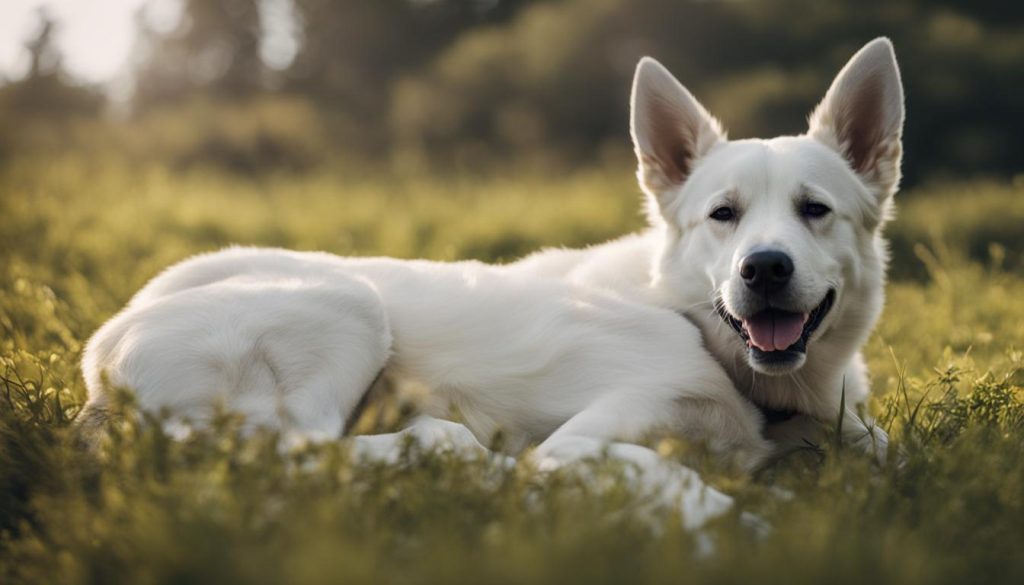
When your dog buries its head into you, it’s important to react appropriately based on the underlying cause of the behavior. Understanding the reasons behind this behavior will help you provide the comfort and support your dog needs.
If your dog is burying its head into you out of affection, a gentle response such as petting or cuddling can be an appropriate reaction. This will reinforce the bond between you and your dog and let them know that their affection is reciprocated.
However, if your dog’s head burying behavior is a result of anxiety or fear, it’s crucial to provide comfort and reassurance. Avoid making any sudden or loud movements that might increase your dog’s anxiety. Instead, try redirecting their focus to a toy or treat, or engaging them in a calming activity such as a relaxing walk or gentle playtime. If the behavior persists or becomes disruptive, it may be necessary to seek professional help from a dog trainer or behaviorist who can provide guidance on addressing anxiety and setting boundaries.
Remember, every dog is different, and what works for one dog may not work for another. It’s important to observe and understand your dog’s body language and behavior to determine the best course of action. Reacting with patience, understanding, and providing the appropriate level of comfort and guidance will help create a trusting and loving bond with your furry friend.
Table: Reacting to Your Dog Burying Its Head into You
| Behavior Cause | Appropriate Reaction |
|---|---|
| Affection | Gently pet or cuddle your dog to reinforce the bond |
| Anxiety or Fear | Provide comfort and reassurance, avoid sudden or loud movements |
| Excessive or Disruptive Behavior | Seek professional help from a dog trainer or behaviorist |
Do Some Breeds Bury Their Head More Than Others?
While head burying behavior can be observed in dogs of all breeds, some breeds may be more prone to this behavior due to their genetics or temperament. Breeds historically used for burrowing or digging, such as Dachshunds or Terriers, may be more likely to exhibit head-burying behaviors. These dogs have a natural instinct to dig and burrow, so burying their heads can be an extension of this behavior. Additionally, breeds known for their close bonds with humans, such as Labrador Retrievers or Border Collies, might also show this behavior as a sign of affection and a way to seek comfort.
Understanding a dog’s breed characteristics can help pet owners better understand and respond to their behavior. For example, if you have a Dachshund or a Terrier, it’s important to provide them with appropriate outlets for their natural digging instincts, such as designated digging areas in the yard or interactive toys. On the other hand, if you have a Labrador Retriever or a Border Collie, it’s crucial to provide them with plenty of mental and physical stimulation to prevent boredom and anxiety.
| Breed | Head Burying Behavior |
|---|---|
| Dachshund | More likely to exhibit head-burying behavior due to their instinct to dig and burrow. |
| Terrier | Prone to head burying as a result of their historical use for burrowing. |
| Labrador Retriever | Might bury their head as a sign of affection and seeking comfort. |
| Border Collie | May bury their head when they feel bonded with their owner and seek a sense of security. |
Please be aware that while certain breeds may be more predisposed to head burying behavior, individual dogs within those breeds may exhibit different tendencies based on their unique personalities and experiences. It’s always best to observe and understand your own dog’s behavior rather than making generalizations based solely on breed characteristics.
Should I Be Worried About My Dog Burying His Head Into Me?
If your dog regularly buries his head into you, there is usually no cause for concern. This behavior is often a natural expression of affection, comfort, or seeking reassurance. However, in some cases, it may indicate underlying issues such as anxiety or medical problems, which may require further attention.
One potential cause for head burying behavior is dog anxiety. Dogs may bury their heads into their owners as a way to seek comfort and security when they are feeling anxious or fearful. This behavior can be more common in dogs with separation anxiety, as they rely on their owners for emotional support.
While most cases of head burying behavior are harmless, excessive or obsessive head burying, along with accompanying symptoms like loss of appetite or changes in behavior, may indicate a more serious underlying issue. It is important to consult a veterinarian if you notice these signs, as they can help determine if there are any medical problems contributing to the behavior.
| Signs to Look Out For: | When to Consult a Veterinarian: |
|---|---|
| Excessive or obsessive head burying | If the behavior is causing distress to the dog |
| Loss of appetite | If there are accompanying symptoms like loss of appetite or changes in behavior |
| Changes in behavior | If the behavior becomes disruptive or interferes with daily activities |
Remember, as a pet owner, it is important to observe your dog’s behavior and understand their individual needs. If you have any concerns about your dog’s head burying behavior, consulting a veterinarian is always a good idea to ensure your furry friend’s well-being.
Is It Common for Dogs to Burrow Their Heads in People?
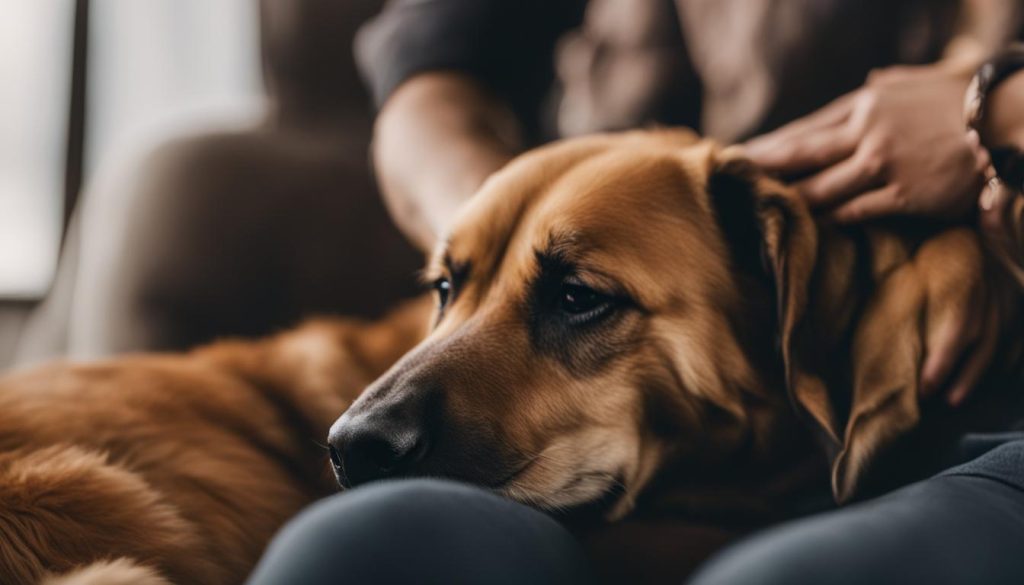
It is indeed common for dogs to burrow their heads in people, especially when they feel comfortable and have a strong bond with their owners. This behavior is a natural expression of their canine instincts, a way for them to communicate, and an act of affection. Dogs have a deep-rooted desire for social connection and often seek physical contact with their owners as a way to establish a pet-owner relationship and show their love and affection.
“When my dog buries his head in me, it makes me feel loved and cherished. I know that it’s his way of showing me that he trusts and relies on me for comfort and security,” says dog owner, Sarah.
When a dog burrows its head in a person, it can also be a way for them to seek comfort and a feeling of safety. Just like humans, dogs can experience fear or anxiety in certain situations, and burying their heads is a way for them to find solace in the presence of their trusted human companion. It’s an instinctual behavior that harkens back to their ancestors who sought shelter and protection in dens.
The act of a dog burying its head in a person also helps to strengthen the bond between the dog and its owner. It allows them to establish a sense of intimacy and closeness, as well as maintain a physical connection. It’s important for pet owners to embrace and cherish this behavior as it is a testament to the special and unique relationship they share with their furry companions.
| Reasons Dogs Burrow Their Heads in People |
|---|
| Expressing love and affection |
| Seeking comfort and security |
| Establishing a pet-owner bond |
| Showing trust and reliance |
| Seeking solace during fearful situations |
Summary:
It is a common and natural behavior for dogs to burrow their heads in people. It is a way for them to express love, seek comfort, establish a pet-owner bond, and find solace in fearful situations. Pet owners should embrace and cherish this behavior as it strengthens the connection between them and their dogs.
The Difference Between Head-Pressing and Burying Their Head
When it comes to dog behavior, it’s essential to understand the difference between head-pressing and head burying. Head-pressing is a behavior where a dog presses the top of their head against a flat surface for an extended period. This behavior can be a cause for concern as it may indicate underlying medical issues or neurological conditions. If you notice your dog engaging in head-pressing behavior, it is crucial to seek immediate veterinary care.
On the other hand, head burying behavior is a natural form of canine communication. Dogs may bury their heads into their owners as a way to express affection, seek comfort, or bond with their human companions. This behavior is typically harmless and reflects the close relationship between dogs and their owners.
To better understand the distinction, let’s summarize the key differences between head-pressing and head burying behavior:
Table: Difference Between Head-Pressing and Head Burying Behavior
| Behavior | Head-Pressing | Head Burying |
|---|---|---|
| Description | Pressing the top of the head against a flat surface | Burying the head into a person or object |
| Indicates | Possible medical issues or neurological conditions | Expression of affection, seeking comfort, or bonding |
| Recommended Action | Seek immediate veterinary care | React appropriately and enjoy the bond with your dog |
Head-pressing behavior is a red flag that something may be wrong with your dog’s health. If you observe this behavior, it’s crucial to consult a veterinarian to identify any underlying medical conditions or neurological issues. On the other hand, head burying behavior is a common and natural way for dogs to show affection and seek comfort. As long as it doesn’t become excessive or disruptive, there’s no need to worry.
Reasons Your Dog Might Bury Their Head in You
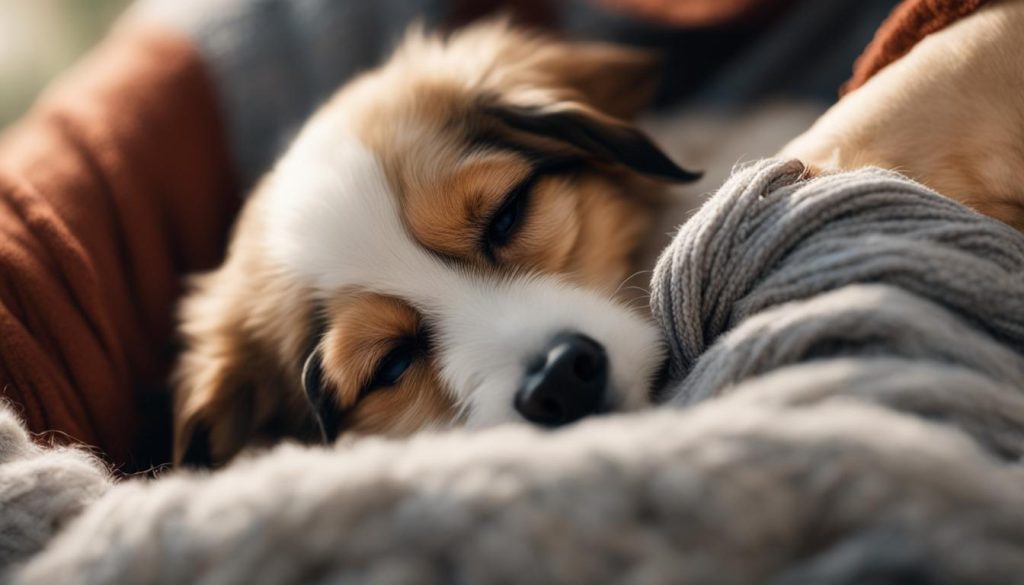
If your dog frequently buries their head into you, it can be a sign of various reasons. One of the most common reasons is a display of love and affection. When a dog buries their head into their owner, it is their way of expressing their deep bond and attachment. This behavior is often seen when dogs feel safe, comfortable, and secure with their owners.
Another reason for head burying behavior is seeking comfort. Dogs may bury their heads into their owners when they are feeling fearful or anxious. It provides them with a sense of security and helps them cope with their emotions. This behavior is especially common in dogs with separation anxiety or fear-related issues.
Some dogs may bury their heads into their owners as a way of marking territory. By leaving their scent on their owners, they are claiming ownership and showing their connection. Additionally, head burying can also be a sign of seeking reassurance. Dogs may bury their heads into their owners when they are uncertain or stressed, seeking comfort and validation.
Table: Reasons for Dog Head Burying Behavior
| Reasons | Explanation |
|---|---|
| Expressing Love and Affection | Dogs show their deep bond and attachment |
| Seeking Comfort | Dogs find security and cope with fear or anxiety |
| Marking Territory | Dogs claim ownership and show connection |
| Seeking Reassurance | Dogs seek comfort and validation in uncertain situations |
Understanding the reasons behind your dog’s head burying behavior can help you better respond to their needs. It’s important to provide a nurturing and supportive environment, address any underlying fears or anxieties, and reinforce positive behaviors. Remember, each dog is unique, and their behavior should be assessed individually to ensure their well-being and strengthen the bond between you and your furry friend.
What Can You Do About Head Burying?
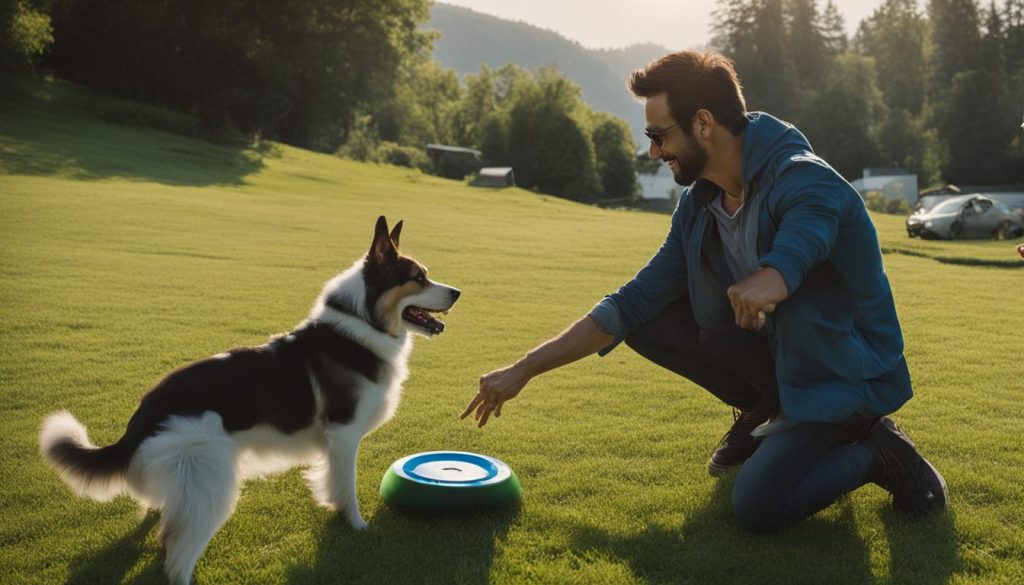
Managing dog behavior, including head burying, requires understanding the underlying reasons behind the behavior and implementing effective strategies to address it. Here are some approaches you can take:
- Positive reinforcement: Use rewards such as treats, praise, and petting to reinforce desired behaviors. When your dog displays alternative behaviors to head burying, such as sitting calmly or engaging in play, reward them to encourage the new behavior.
- Redirecting attention: Distract your dog from head burying by redirecting their attention to a toy, a puzzle feeder, or an interactive game. This will help shift their focus away from the behavior and engage them in a more appropriate activity.
- Addressing anxiety: If head burying is a response to anxiety or fear, work on addressing the underlying issues. Create a calm and secure environment for your dog, provide plenty of exercise and mental stimulation, and consider desensitization and counterconditioning techniques. Consulting with a professional dog trainer or behaviorist can provide valuable guidance in addressing anxiety-related behaviors.
- Seeking professional help: If the head burying behavior persists or becomes problematic, it may be necessary to seek professional help. A qualified dog trainer or veterinary behaviorist can assess the behavior, determine any underlying issues, and provide expert guidance on managing and modifying the behavior effectively.
Remember, consistency, patience, and a positive approach are key when modifying any dog behavior. By understanding the reasons behind head burying and implementing appropriate strategies, you can help your dog develop healthier ways to express their emotions and strengthen your bond.
Wrapping Up
Understanding why dogs bury their heads into their owners is key to interpreting their behavior and fostering a strong bond. Whether it’s an expression of love and affection, seeking comfort or reassurance, marking territory, or responding to anxiety or fear, dogs use head burying as a form of communication.
By reacting appropriately, addressing any underlying issues, and providing a nurturing and supportive environment, pet owners can strengthen their relationship with their dogs and ensure their well-being.
FAQ
Why does my dog bury his head into me?
Dogs bury their heads into their owners as a sign of seeking comfort and security. It can be a way for them to express love and emotions, claim space, seek reassurance, enjoy their owner’s scent, play, or preserve body heat in cold weather.
Why do dogs nuzzle their head in you?
Dogs nuzzle their heads into their owners for various reasons. Some common reasons include expressing love and emotions, seeking reassurance due to anxiety or fear, claiming space, enjoying the owner’s scent, using it as a strategy to get attention, displaying affection during play, or preserving body heat in cold weather.
How should I react when my dog buries its head into me?
Your reaction should depend on the cause of the behavior. If it’s out of affection, gentle petting or cuddling can be appropriate. If it’s due to anxiety or fear, providing comfort and reassurance can help calm the dog. Avoid loud or sudden movements that might increase anxiety. Seek professional help if the behavior becomes excessive or disruptive.
Do some dog breeds bury their head more than others?
While head-burying behavior can be observed in dogs of all breeds, some breeds may be more prone to this behavior due to their genetics or temperament. Breeds historically used for burrowing or digging, such as Dachshunds or Terriers, may be more likely to exhibit head-burying behaviors. Breeds known for their close bonds with humans, such as Labrador Retrievers or Border Collies, might also show this behavior as a sign of affection.
Should I be worried about my dog burying his head into me?
Head burying behavior in dogs is typically harmless and a natural expression of their emotions. However, if the behavior becomes excessive, causes distress to the dog, or is accompanied by other symptoms such as loss of appetite or changes in behavior, it may be necessary to consult a veterinarian to rule out any underlying medical issues.
Is it common for dogs to burrow their heads in people?
Yes, it is a common behavior, especially when dogs feel comfortable and bonded with their owners. It’s a way for them to show affection, seek comfort, and establish a sense of security.
What is the difference between head-pressing and burying their head?
Head-pressing is a rare behavior where a dog presses the top of their head against a flat surface for an extended period, indicating serious medical issues. Burying their head, on the other hand, is a natural behavior expressing affection or seeking comfort.
What are some reasons my dog might bury their head in me?
Some common reasons include expressing love and affection, seeking comfort during anxious or fearful situations, displaying empathy when their owners are upset, seeking reassurance during separation anxiety, alerting the owner of possible danger, or marking their territory with their scent.
What can I do about my dog’s head burying behavior?
You can try avoiding rewarding the behavior with attention or treats, redirecting the dog’s attention to toys or other activities, addressing underlying anxiety or fear through increased interaction and creating a safe environment, and seeking professional help if needed to establish boundaries and manage the behavior.


